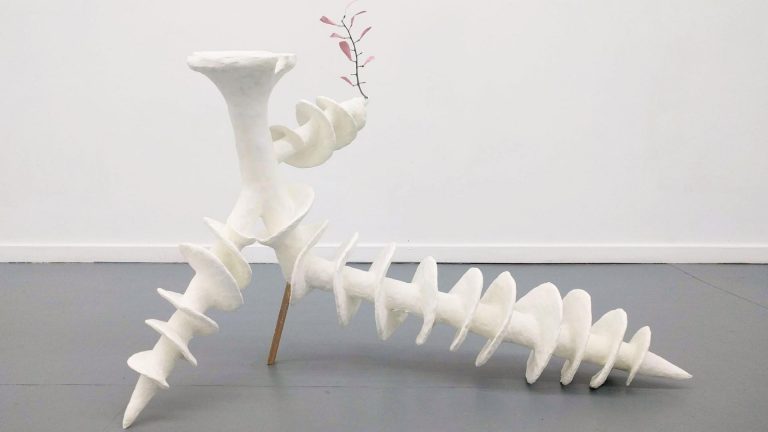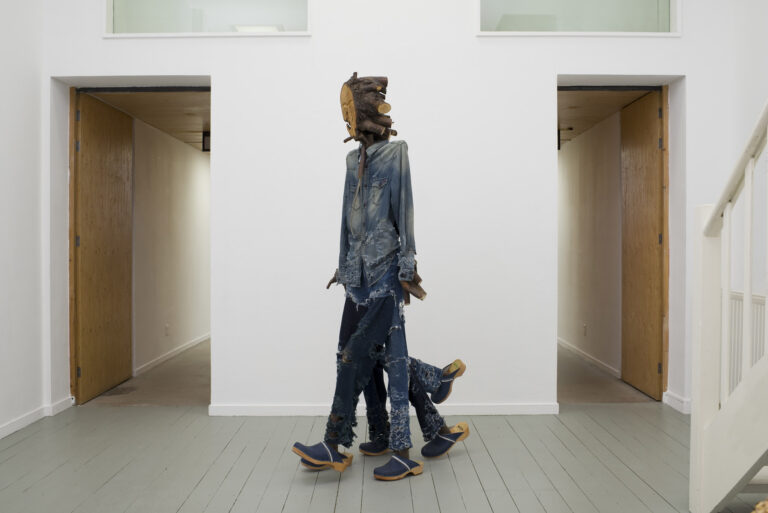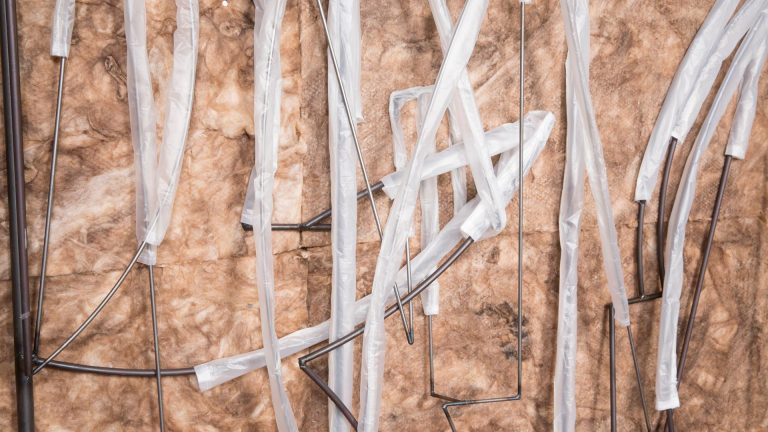Artist: Giulia Cenci
Exhibition title: backland
Venue: Galerie Fons Welters, Amsterdam, The Netherlands
Date: September 3 – October 9, 2021
Photography: all images copyright and courtesy of the artist and Galerie Fons Welters, Amsterdam
Q&A – Giulia Cenci and Jip Hinten
Themes such as repetition and reproduction, as well as death and decay, have been central to Giulia Cenci’s sculptural research since her studies at the art academy of Bologna. A research that includes everything she moves into the empty space of her studio. She makes casts of found objects, discarded items or no longer working machines. The materials she uses are not classic materials such as bronze or copper, but Cenci consciously opts for cheap alternatives such as silicone, resin and plaster – raw materials that are commonly used in industrial production processes of goods intended for rapid mass consumption.
Gradually, Cenci has increasingly integrated her sculptures into space-filling installations, to the point where not only the sculptures are dominant, but also the architecture of the space. “The front space of Galerie Fons Welters is a very interesting space: long and narrow like a corridor. A form that evokes associations for me with production chain spaces where repetition is central. In this way the space directs the work, and the work directs the space, resulting in a situation that the viewer can experience.” The viewer is not expected to just passively watch, but to immerse himself in the work, to move through it. A movement that is not entirely steered by free will, but that, as Cenci describes, is driven by the structure of the work.
The installation is based on the animal stable, in which activities such as eating and reproducing are central, and are commercialized on a large scale. A place where life is confined to minimal space and consists only of the basic conditions of existence. During my recent vacation, I came across the following description of cows in a stable in one of the novels I brought with me: “All of them absorbed in an animal existence with a paradisiacal lack of spiritual depth: squirt and chew, shit and piss, graze and sleep – that was their only reason to exist.” Instincts – sometimes overlooked by humans in the turmoil of everyday life – that take centre stage again during a holiday period. Strolling, lazing about, eating and drinking: banal things that we are only too happy to fill our holidays with. Tuscany, the place where Cenci was forced to stay recently, evokes similar associations with vacation and freedom for me. However, for Cenci, as a result of the current pandemic, this place has become one of restriction and confinement. But the former farm that serves as Cenci’s temporary workshop has also provided her with the materials that form the basis of her installation at the gallery: the remains of a steel agricultural machine that was used to transport materials.
In the gallery space, the visitor is confronted with seven figures, consisting of distorted human, animal, and human-animal-like hybrid forms. A row of five identical creatures with only a head and an arm, are engrossed in a simple but rather gruesome activity: each creature seems to slowly eat its own arm.
Cenci explains that the uniformity of the figures, the literal repetition of their form and action, refers to a destruction of ‘the self’. By presenting one of the five creatures separately from the group, Cenci emphasizes the distinction between collective and individual. The figures raise questions about the position of the individual within society. Is there still room for an ego, an ‘I’, and what is the value of this? Where is the boundary between this ‘self’ and society, and is it (still) justified to put the needs of the individual above those of the group? Whether we operate as an individual or as a group, we all depend on the same basic needs as eating, sleeping and procreating to survive.
Further, two more figures await the visitor for a confrontation: a battered, double human head resting on an old car seat and an elegant, wolf-like creature of which it is not entirely clear whether they are merely there to be watched or whether they are watching you. The wolf, which can symbolize solidarity, fidelity, intuition, loyalty and freedom, but has also bitterly exposed the division in human attitude towards nature since its recent return to the Netherlands. The story of the ‘big bad wolf’ seems to prevail in our current over-cultivated society. The fear of losing control overrides an acceptance of the natural balance, with all the catastrophic consequences that entails.
In addition to the space in which Cenci’s works are located, the materials she uses to composes them also play a very decisive role. Her creatures consist of casts of body parts of stuffed animals, combined with all kinds of objects collected by Cenci. Cenci prefers to transform materials to such an extent that their original function is no longer recognizable. For example, the arms of the creatures seem to be made of (animal) bones, but they consist of pieces of wood, and also the animal heads and body parts are no longer completely recognisable. Cenci explains the effect this handling of materials has on her work: “What I find interesting is the realization that the desire to shape my personal, subjective sketch is influenced by the material I encounter. The material controls the final result of the work, which creates a visible and palpable tension.”
The assembly of fragmentary body parts and machine parts leads to alienating and somewhat morbid creatures. Creatures that confront us with the, according to Cenci, inevitable ugliness of death and decay. Cenci presents us not with the dream, but with the nightmare. And it is precisely the nightmare that can wake us up.
Man, animal and cage are fused into one hybrid form. The hierarchy between man, animal and machine is dissolved. In this disturbing landscape, man loses his privileged position; no longer a leader, but forced to be led by Cenci’s oppressive spaces. The wolf, quietly watching without being an active part of the scene, seems to have more control than man, who has to move uncomfortably through the whole to get to the end. Have you, without realizing it, been led like a sheep to the slaughter?
Giulia Cenci (Cortona, IT, 1988) studied in Bologna and Den Bosch-Breda and took part in de Ateliers. Selected solo shows include Museo Novecento, MUDAM, SpazioA. Cenci’s work is included in the collections of Fondazione Sandretto Re Rebaudengo, Turin, IT; Mudam, Luxembourg, LU; MAXXI Museum, Rome, IT, among others.
She has been recently awarded the Baloise Art Prize at Art Basel 2019 and shortlisted for the MAXXI BVLGARI PRIZE 2020.
The artist lives and work between Amsterdam and Tuscany.
Jip Hinten is Junior Curator at the Kröller-Müller Museum in Otterlo, Netherlands and part of the curatorial team at Exhibition Space 38CC in Delft.




















